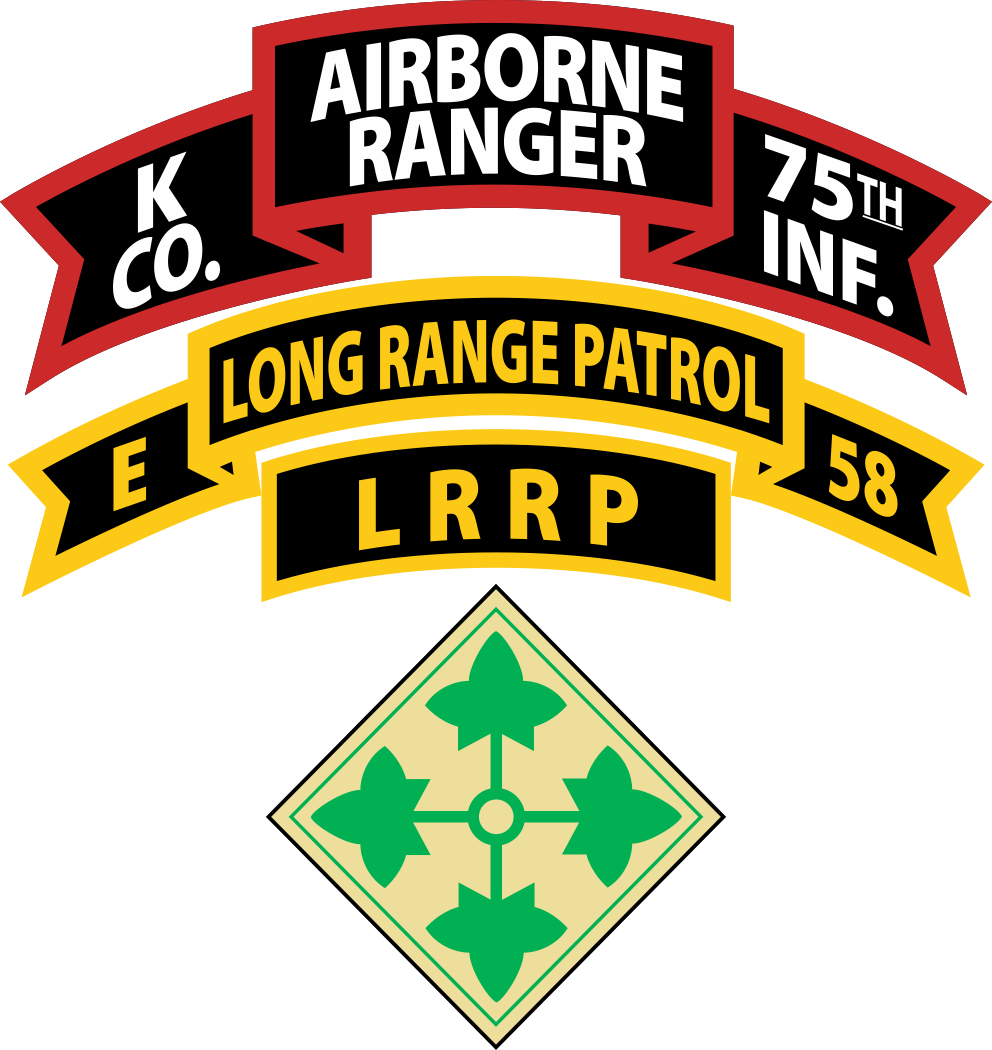Joseph “Joe”John Steimbach
SP/5 – U.S. Army
4th Inf Div 2nd Bde LRRP
23 July 1945 – 12 April 1968
Jacksonville, Florida
Panel 49E, Line 36
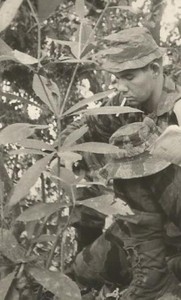
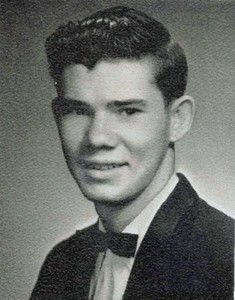
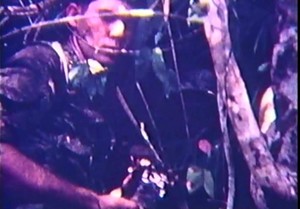
Removing booby-trapped SKSs from VC arms cache, February 1968
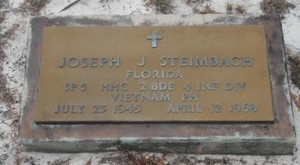
MILITARY DATA
Service: Army (Regular)
Grade at loss: E5
Rank: Specialist Five
ID Number: 14925812
MOS / Specialty: 11B4 – Infantryman
Len Svc: 2 years
Unit: 4 INF DIV, 2nd Bde LRRP
CASUALTY DATA
Start Tour: 18/02/1967
Cas Date: 12/04/1968
Age at Loss: 22
Remains: Body recovered
Location: Pleiku, South Vietnam
Type: Hostile, ground casualty
Reason: Gun, small arms fire
AWARDS
National Defense Service Medal, Combat Infantryman Badge, Purple Heart, Vietnam Campaign
Medal, Vietnam Service Medal
GRAVESITE
Oak Grove Cemetery, McClenny, Florida
Link to Remembrances:
https://www.vvmf.org/Wall-of-Faces/49639/JOSEPH-J-STEIMBACH
Link to Personal Comments:
https://www.thewall-usa.com/guest.asp?recid=49648
2nd Bde LRRP Platoon Sergeant Bob Smyers Writes –
I remember interviewing Joe for the LRRP platoon along with his close friend John Gibson. They were both eager soldiers and came together. Joe was a good man as well as a contribution to our platoon as a soldier ready and willing to do what needed done to accomplish the mission. He was proud of the LRRP’s and made it known. He even wrote a story about what he felt the men of the LRRP’s were about. Called “Kind and Deadly.” Someone carried it back to the world and it is now on the internet. Joe may be gone but he lives in the hearts of those whom he fought alongside of and is thought of often. I remember the last time I saw him, March 25, 1968. I had just came in off a mission and was headed for home and Joe as always had his camera and took pictures of the team and me with a promise he would send me some. I got word 16 days later he had been killed while on patrol. I had never during my tenure lost a man and now Joe was the first. It hit really hard. This July (2000) I stopped at Ft, Benning, Ga and paid tribute to him at the Ranger Memorial where his name is engraved in the Ranger Walk. SUA SPONTE….RLTW…
I also remember Joe Steimbach, my team leader who showed me what to do in order to survive on the teams…
Nick “Poz” Posdniakoff, 2nd Bde LRRP (Feb 1968 – Feb 1969)
After the disaster of my first trial mission with Sgt. Johnson in early February 1968 at the Oasis, our CO, Cpt. Garnet, decided to give me another chance. I managed to pass my second trial L.R.R.P. mission with Sgt. Valeen, but needed the evaluation and endorsement of another team leader to qualify me as a L.R.R.P. trainee. SP/5 Joe Steimbach, a quiet, wiry, intense Southerner, was in his early twenties, but was known as the old man in the platoon. This was because of his experience in the jungle and judgment skills as a patrol leader. During the past year, he had not lost a single man, dead or wounded, on his teams. Steimbach was to show me the special patrolling techniques of his recce team Hotel-2-Alpha.
The mission with Steimbach was routine: check out an abandoned VC staging area that the L.R.R.P.s had mapped before, look for any new activity, and acquaint me with how the enemy operated in the field. We found the old camp hidden in the jungle, deserted as before – a collection of shaky hootches with remnants of grass roofs, bamboo storage platforms set up from the ground, and a few earthen bunkers already starting to collapse from lack of use. Not much more. The rain had washed open several narrow entrances to tunnels and spider holes excavated into the hillside. Normally, if well concealed, we would have walked right by them. Steimbach, twisting his shoulders, squeezed into the widest cave opening, but his chest became stuck. As none of my other teammates were eager to search the holes, I quickly volunteered to venture inside: flashlight in one hand and my little .380 pistol in the other. I had to show my new teammates what I could do.
I heard Steimbach yelling after me not to touch anything!
The opening was very tight, not much different from crawls in the Hawaiian lava tubes I was used to exploring just over a year back, and ended abruptly after only ten meters. It was a weapons cache. At the end of the narrow passage, pointing directly at me, I could see the shiny barrels of a bundle of Chinese SKS rifles, balanced on tripods cut from bamboo to keep them off the damp ground. Trophies!
Ignoring Steimbach’s instructions, I inched forward, grabbed the barrels, and pulled them carefully towards me. There was a soft snap, but nothing happened. Excited, I crawled backwards out of the hole dragging the enemy weapons behind me, eager to show off my find to my teammates.
Outside, Steimbach, furious, was yelling at me again… this time pointing to the scraps of rotten vine attached to the triggers of the loaded weapons, the source of the snapping sound. If the VC had owned some real shoelaces instead of having to use vines, I would still be lying in that narrow tunnel with a few bullet holes in my chest. Only a tiny Montagnard tribesman could have slipped carefully along the wall to disarm such a trap. We tossed all our tear gas grenades into the remaining tunnels. The fine CS powder would stick to the dirt passages for months. Anyone crawling around would stir it all up again and hopefully choke himself senseless.
* * *
Two months later, after graduating from the 5th Special Forces RECONDO School in Nha Trang, I was Hotel-2-Alpha’s point man, on another mission with team leader SP/5 Steimbach. We were looking for the NVA 95th Regiment’s headquarters, suspected to be hidden in the Ia Drang Valley, less than 20 minutes’ flight from our Oasis.
Only a few years before, over 300 G.I.s had lost their lives fighting the NVA in Ia Drang. There were no Americans in Ia Drang now; it was still Charlie’s valley.
After our usual insertion at last light and uneventful first bivouac, we started our measured approach into Ia Drang early the next morning. The vegetation was dry and sparse: flat scrub jungle forest, no signs of any enemy presence. We were moving quickly, focused on getting into the valley and closer to our objective. It took us another full day and bivouac to reach the green, wet blanket of jungle that smothered the Ia Drang River.
It became darker and more ominous now, as we sank deeper into the valley… circumventing large moss-covered trees, whose snake-like roots constantly snared at our feet to trip us. Their tops reached over 100 feet into the air, with dense triple canopies of branches blocking out the sunlight. Vines with long sharp spikes jabbed at us. The soft ground was oozing under our boots, sucking at them with an unholy tenacity, as if trying to swallow us whole. Eerie cries of disturbed birds and angry stutters of monkeys challenged us as we slowly crept through their realm. We made no noise, but they all knew perfectly well that we were there. In their jungle. It was sinister. We did not belong here. We recognized it, and so did the jungle around us.
Our movement became slower, more cautious, but a feeling of exhilaration took over when we started to feel the enemy presence around us. We couldn’t see Charlie yet, but we sensed him near us. There was nothing absolute – just a well-used trail suddenly appearing directly in front, an occasional metallic clink somewhere far off, an unfamiliar rustling noise, soft echoes of digging in the distance, the sound of chopping wood, perhaps the snatches of a voice and a faded response, the faint scent of nÆ°á»›c mắm – the pungent Vietnamese sauce made from fermented fish. We all vaguely felt the presence of many men nearby – but where were they?
I was on point, keyed-up, eager to march nearer the trail to observe the enemy better. Now, it was risk versus gain. To see the enemy I had to give up cover. The more I wanted to observe, the more danger I had to assume, and a boundary between calculated risk and recklessness had to be determined.
Steimbach called me back. It was too risky for the entire team to advance any closer. The men would hide in a thicket while Steimbach and I approached the enemy positions alone. We crept out silently, two shadows glued together. I focused all my attention and senses on what was in front, while Steimbach covered our flanks and rear. When my focus started to fade, we changed positions. We could move easily now without our heavy packs on our backs. I followed the trail in parallel for about an hour, just far enough away to remain concealed. It was slow and careful going because of the dense vegetation and I was envious of Charlie, who could move quickly along that well-beaten trail just meters away from us.
Searching for the enemy base camp, I almost fell into an empty NVA fighting position! I learned what an enemy base camp really looked like. It was nothing like our base camp, that was for certain. We had airstrips and motor pools, fortified sandbagged bunkers, wooden barracks, tents, observation towers; all ringed by a gauntlet of razor-edged barbed wire protected by mines, trip flares, and motion detectors. The enemy’s base had no fixed perimeter at all, just a series of mutually-supporting low earth-and-log bunkers, dug deep into the ground. Nearby fighting positions were connected by a series of trenches, and simple camp-kitchen shacks were covered by camouflaged thatched roofs. The NVA lived underground in their bunkers. The entire complex was built under triple canopy tree cover, invisible from the air.
From the empty fighting position, through the bushes, we could glimpse some of the bunkers, covered with branches and leaves, and silhouettes of NVA soldiers moving around them. Steimbach brought the scope of his M-14 sniper rifle on the targets to identify weapons and equipment. I snapped a few photos with my Olympus Pen-EE camera. I took out my square plastic protractor to get the exact coordinates of the enemy base plotted on the grid square of my map. The analysts back at S-2 intelligence were always asking for this type of information. I was in an adrenaline-fueled rush to continue to skirt the base and map out its dimensions. So far, we had seen a few bunkers, but we needed more information.
Crawling carefully alone along the empty firing positions, I heard voices in the foliage. On my knees, I silently inched closer, slowly moving the vines out of the way. A tiny window offered me a peek at two NVA soldiers in green uniforms sitting by their bunker cleaning their gear – AKs leaning by the side, and pith helmets on the ground. They were laughing and talking quietly, not looking toward me. I was fascinated, examining their faces from about eight meters away, for a moment totally forgetting where I was.
Communist soldiers right in front of me!
Suddenly, one of the NVA, an older man with a curious expression on his face, still half-smiling from a joke with his comrade, turned his eyes casually in my direction. He quickly averted his glance and continued to talk softly to his fellow soldier. I dropped to the ground in a sudden panic.
Did he spot me? No way, my face was just a black smudge in the foliage eight meters away.
I crawled silently to Steimbach and we decided to head back quickly to re-join the team. It was far too risky to remain here much longer. An hour later, we were still following our path back paralleling the trail, when we heard the single shot…
Blapp!.. It sounded like the unique “pop” made by an AK-47.
Seconds later… Blapp! We heard the second single AK shot some distance away in response.
Steimbach froze in shock and sudden realization. The NVA were looking for us! They were already formed in a long line of troops sweeping the jungle for us – periodically; each end element would fire a shot to mark the movement of the line and to keep it straight.
We the stalkers had now become the stalked!
The single shots were still being fired randomly as we rejoined our team members, who surrounded us with great relief and excitement. No time for any explanation or rest. We had to run from that rapidly approaching line and find an LZ for our extraction. Steimbach was already on the radio explaining the situation to the Oasis.
Still on point, I was no longer quietly moving step-by-step, but running with determination while trying to keep the panic at bay. I had to think about compass bearings and the directions of the LZs marked on my map. I had to be alert and think as well about the enemy who was out there looking for us.
The jungle opened suddenly and I found myself before a clearing that was 30 meters wide, facing a wall of jungle on the other side, about 20 meters away. It was not marked on my map, but a helicopter could easily land here. I relaxed. We were saved! First, however, I had to cross this clearing and secure it from the opposite side while the RTO set up his radio to call for our extraction.
I moved quickly up into the center of the clearing when a deafening blast of automatic fire suddenly let out from the underbrush directly in front. Terrified, I dropped instantly to the ground like a stone. Mechanically, I pegged the tok-tok-tok sound to a Chinese RPD light machine gun that fired faster than an AK. But, I was quickly frozen with fear as the rounds were impacting just next to me, rustling up the dirt in a calm whooshing sound, like they were trying not to disturb me too much.
Whoosh… don’t worry, we’ll get to you soon… Whoosh… they seemed to promise maliciously.
The enemy gunner knew exactly where I was, while I could see nothing but the tall grass and green wood line in front. I hugged the ground closely, automatically focusing on the impacts of the bullets around me, and closing out who was doing the actual shooting. My immediate reaction was to push myself deeper into the ground, or make a mad dash back to the safety of the team behind me. But another blast from the RPD that blew away clumps of grass just inches from my head told me not to run anywhere.
I pressed myself closer and deeper into the soft earth, absorbing the rich odors of torn-up grass and musky jungle vegetation. It felt safe inside here. A little green insect was crawling slowly up a broken stick directly in front of me, lifting one leg deliberately at a time, totally oblivious to the mayhem around it. Where was he going, I thought. It was not the right way…
Then, my training took over. Instinctively, I quickly low-crawled to a log that offered some flimsy cover, completely mindless of the heavy pack on my back. I still could not see the enemy at the tree line, but I made desperate eye contact with Steimbach, who was hiding behind the same tree I had used for cover just moments before making my way into the clearing. The enemy machine gunner continued to blast my log each time I raised my head to look around. Another shooter peppered Steimbach’s tree with an AK from the same position. I didn’t know what to do. I just fired my CAR blindly into the dense jungle wall in front. It stifled my fear.
In this high-stress situation, the instinct to survive made my mind work in different ways. Events exploded around me in a furious flash of action, but everything appeared to be drawn out in slow motion to me. My mind separated all that was going on into individual compartments, or windows, that I could address separately, and in detail. One window was the enemy in front where my mind tried to calculate the precise location of the danger, and fix the target. Another window was the personal communication established with my teammates, who were also alert to the same threat and working with me on a joint reaction to the enemy ambush. A third window was the need to change the magazine of my weapon, or focus on the shrill cries of a wounded soldier coming from somewhere nearby. Was he one of ours?
I dealt with the stress by instinctively skipping through all the unpleasant and distracting windows around me, and focusing on the most significant details that had to be processed first – information that dealt immediately with the survival of my team. Blanketing my thoughts was that pervasive envelope of fear, a dark fog that threatened to overwhelm my thinking into blind panic. It was constantly pushing to close my windows and take over.
No! I had to force myself to open the windows one by one, and push the fear back into its own compartment. With my full attention constantly jumping from one event to another there was little space for the fear to creep in. I crawled in small advances to get closer to the safety of the wood line in front, to flank the enemy, with each motion getting a better fix on the position of our target. Steimbach and the others were providing supporting fire to cover my measured movements forward. To keep the fear at bay, I talked aloud to myself, as if to another person…
Calm down… hold your fire… wait until you actually see the hostile target… see that rock in front… get behind it… aim for the smoke coming from the enemy muzzle… exhale… relax and squeeze the trigger slowly…aim to the right of that little red bush in front… fire… now, shoot a foot higher… yes, that’s it… throw the grenade, quick… get closer now… I had to think about constantly moving and not getting pinned down by that machine gun.
The single AK shots were becoming more frequent now in the distance behind me. The NVA line was closing in on us from the rear. Another RPD machine gun opened up noisily on our right flank in a crossfire. Now, I finally realized that we had fallen into a well planned ambush. We were trapped! The NVA’s long search line had forced us into a bottleneck where another NVA blocking team was already waiting to hit us from both sides.
There was no way to escape from such an ambush other than to charge the NVA position directly in front because its other well-placed and hidden members on the flanks would wipe out any one of us who thought he could run through them to safety.
Steimbach gave me the hand signal to attack forward while he extended the tube of his M-72 LAW. He aimed the rocket launcher at the NVA machine gun nest directly in front of us, 25 meters away. The missile thundered into the tree line and exploded in a terrific crash…
* * *
Suddenly, my mind took me back to Pupukea on the North Shore of Oahu not so long before. It was a windy 10-foot day; I was paddling out on my longboard. The waves were steep lefts and curling very fast. My heart was in my throat each time I saw the exposed coral heads below, as I pulled back at the last moment letting the waves go by me one by one. I was beyond my limits, panic creeping in. Then, finally, I saw a big dark wall that was curling up angrily behind me. I had to take off now or be smashed on the shallow reef! I exhaled all the air from my lungs and dug my arms fast and deep into the water, flexing my weight forward to get quickly over the lip, take the fearful vertical drop, and make my escape….
* * *
I tore myself from the ground and ran like the wind towards the smoke marking the impact of Steimbach’s rocket, firing my CAR in rapid bursts. There was no more fear – just desperation and determination. Reloading, I fired again and again, and ran by the twisted RPD lying uselessly on the ground. I just fired and ran, not even looking at the crumpled bodies under my feet, only trying to get past the trap that had been set for us. My teammates were also running right behind me without looking or stopping, occasionally shooting into the green jungle around us. We were all running for our lives.
We ran towards the nearest LZ marked on our map, where fifteen minutes later, the extraction chopper was waiting for us. I waved my red ground signal panel frantically at the hovering bird to guide it in, while one of the door gunners was already blasting the treeline behind us. The other support gunships were firing their miniguns furiously at the NVA pursuing us. With seconds to spare, we all scrambled on the skid of the Huey and pulled ourselves madly up to safety. Steimbach, last man on board, gave me a grin of relief, as he wriggled his shoulders out of the straps of his heavy pack. Another successful mission without any casualties.
We had survived the firefight, and were sprawled out drained on the cold metal deck of the helicopter, hearts pounding, with the howl of the rotors in our ears, as the chopper dipped its nose and brutally clawed its way up to the sky. The explosive bursts from the door gunners’ M-60s chattering around us was deafening – but did not drown out snatches of the song blaring from the pilots’ 8-track tape in the cockpit up front:
Ghost riders in the sky…
A’plowin’ through the ragged skies and up a cloudy draw…
Their brands were still on fire and their hooves were made of steel…
Their faces gaunt, their eyes were blurred, and shirts all soaked with sweat
They’re ridin’ hard to catch that herd but they ain’t caught them yet
They’ve got to ride forever in that range up in the sky
On horses snortin’ fire, as they ride on, hear their cry
Ghost riders in the sky…
We were no longer afraid. That old elation we all felt at the start of the mission had come back to us again.
Every L.R.R.P. mission followed that same mad cycle of emotions for me; exhilaration to panic and back to exhilaration – having to deal with the fear exactly the same way each time as before. I lived each day, one at a time, not imagining any kind of future other than the daily combat patrols in the jungle, and the constant uneasy presentiment of an enemy contact lurking right around the corner.
Could I make it just until it turned dark?
A week later, 12 April 1968, on his next mission, SP/5 Steimbach was dead, shot by the NVA as he was helping a wounded teammate.
* * *
LRRP teammate Tom Jarvis recalls: “I was on the radio relay team when he was hit. I felt so helpless because I couldn’t do anything but call it in.”
Warren Gallion: I copied “KIND AND DEADLY” from a tattered single type written page that I carried with me in Vietnam. I did not recall how I came into possession of this story, but I have since learned from Tom Jarvis that the original appeared in the June 16, 1968 edition of the IVY LEAF which included the following.
(EDITOR’S NOTE; JUNE 16, 1968 -The “Kind and the Deadly” is a story about the members of a 2nd Brigade, 4th Divison Long Range Patrol. It was written by Specialist 5 Joseph J. Steimbach of Jacksonville, Fla., a LRP team leader, shortly before he was killed in action while attempting to aid a wounded team member.)
KIND AND DEADLY
by Joe Steimbach
The man I’m writing about could well be the boy next door, the gentle blonde haired kid from the corner supermarket or the jail bound punk of not so long ago. The boys are bound together by their trade. They are all volunteers, they are all deadly killers. They are in the spine tingling brain twisting, nerve racking, business of the LONG RANGE RECONNAISSANCE PATROL. They vary in age from 18-20.
These men operate in precision in movement, like walking through a jungle quietly, being able to tell whether a man or animal is moving through the brush without seeing the cause of movement. They can sit in an ambush for 10 hours without moving a muscle except to ease the safety off the automatic weapon in their hands as they settle to their main object of killing.
These men are good because they know they’re the best. Called the LRRP’s for short they are despised, rejected, admired and thought to be a little short of brains by those who watch from the sidelines as a team starts out on another mission to kill, harass, cripple and maim the enemy.
They are a team counted on the hand, a finger for each man. They start with eighty pounds of equipment strapped to their backs, sixty pounds of which is ammo, mines, grenades, tripflares and anything conceivable to bring the enemy to his dark end. They are a few who will ambush a company or a battalion of enemy at a moment’s notice, men who will push the enemy until he’s at wits end trying to decide where to run next and he can’t find any place to run. These men put him out of the fight permanently.
These men know they may never see the next sunrise, but they move on, knowing there are gunships that will answer their call for help and artillery that will come screaming in the darkest of night toward and on their positions in case the team is in danger of being eliminated.
They are men who can take a baby or a small child in their arms and stop its crying, share their last smoke, last ration of food, last canteen of water, kind in some ways, deadly in others.
These are the LRRP’s who believe in country, freedom and fellow men. They are a new kind of soldier in a new type of warfare. They look the same as anyone you may have seen in a peace march, draft card burning or any other demonstration, but they are different, just look into their eyes. Better yet just ask them, for they are men. These men stand out in crowds of soldiers. It is not just their tiger fatigues, but the debonair way they walk and stand. You know they are proud because they are members of the LONG RANGE RECONNAISSANCE PATROL.
SP5 Joe Steimbach
* * *
